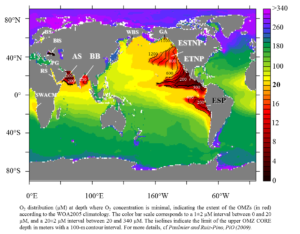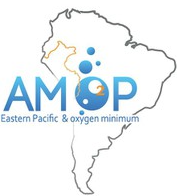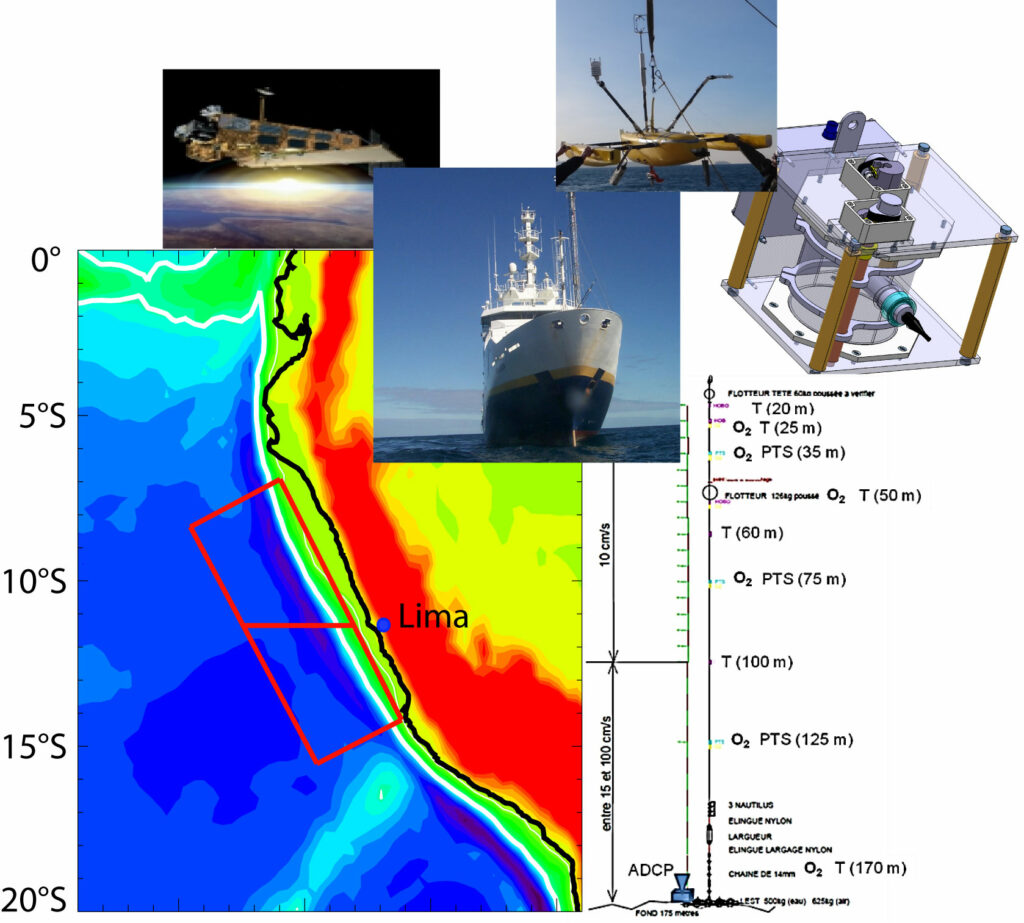Actividades de investigación dedicadas a la Mínima de Oxigeno del Pacifico oriental
Responsable científico: Dr. Aurélien PAULMIER (aurelien.paulmierNO SPAM -- FILTER@NO SPAM -- FILTERlegos.obs-mip.fr
Co-Is: Boris DEWITTE, Véronique GARCON (LEGOS, IRD/CNRS, France), Christophe MAES (LPO, IRD, Francia)
Campaña AMOP: Christophe MAES (Jefe de misión)
Anclaje AMOP: Boris DEWITTE, Aurélien PAULMIER (Co-Is)
Plataforma de modelamiento AMOP: Boris DEWITTE, Séréna ILLIG, Véronique GARCON (Co-Is)
Colaboradores principales: Alemania (SFB754: GEOMAR, MPI); Perù (IGP, IMARPE, UNAC)
Otras colaboraciones: México (CICESE, UABC), Dinamarca (Universidad de Aahrus), España (IEO, CO-Malaga), Chile (CEAZA), EE.UU. (UCLA)
RESUMEN
AMOP es un proyecto trans-disciplinario basado en una campaña oceanográfica, una línea de anclaje y actividades de modelamiento, combinado con una iniciativa de desarrollo experimental (instrumentación, sensores). Su objetivo es de mejorar la comprensión de las Zonas de Mínimo de Oxigeno (ZMO) y la desoxigenación del océano, enfocándose en la ZMO frente a Perú. AMOP se compone de un consorcio de científicos de instituciones peruanas y francesas (IMARPE, IGP, UNAC; LEGOS, MIO, OOV, MARBEC, LATMOS, LEMAR, LPO, OOB, EPOC, LOCEAN, ISTO, US IMAGO, DT INSU), además de gozar de una colaboración con Alemania (SFB754 «Climate-biogeochemistry Interactions in the Tropical Ocean») y otros países: México (CICESE; UABC); Dinamarca (Universidad de Aahrus); España (IEO, CO-Málaga); Chile (CEAZA); EE.UU. (UCLA). AMOP forma parte de los objetivos de programas internacionales (Mid-term strategy OMZ-EBUES SOLAS; Future Earth), y de redes regionales (LMIs DISCOH y PALEOTRACES 2).

AMOP issue and science
Oceanic Oxygen Minimum Zones (OMZs) are known to play a key-role on the evolution of climate (e.g. greenhouse gases production) and living resources from ecosystems to fisheries (e.g.: nitrogen loss, respiratory barrier for zooplankton and fishes). In response to climate and environmental changes, OMZs would contract during cold periods and extend during warm periods. Despite the worrying problem of ocean deoxygenation due to global warming and human activities, OMZs have not been extensively studied. Current global models exhibit severe biases in simulating the vertical and horizontal O2 distribution in the OMZ, although oxygen is one of the first oceanographic parameter being measured.
The AMOP («Activities of research dedicated to the Minimum of Oxygen in the eastern Pacific») project investigates the mechanisms leading to the OMZ existence off Peru and its variability from hourly to centennial timescales. The Central Hypothesis of this project is based upon a two-layers conceptual model of the OMZ: the oxycline and upper OMZ core where physics and biogeochemistry contribute comparably to the rate of O2 changes, and the lower OMZ core where physical processes dominate the changes in O2. Conversely to other studies dedicated to different OMZ impacts, AMOP is focusing on the oxygen parameter, with the objective to carry out a quantitative and comprehensive O2 budget considering physical (advection/diffusion) and biological (O2 consumption/production through bacteria, phytoplankton and zooplankton) contributions.
The project implies a transdisciplinary approach: biogeochemistry, microbiology, physics, coupling with the atmosphere, acoustics, ecology, paleoceanography, all aiming towards the understanding of the O2 fluxes. The approach is based on: i) a 30-day cruise on the Atalante (IFREMER) associated with Argo float deployments that took place in January-February 2014, ii) a long-term mooring (> 1-yr) on one of the historical IMARPE station that was deployed on January 5th, 2013, iii) a modeling platform in order to bridge the gap between sampled and non-sampled spatio-temporal scales, and to assist the interpretation of our full data set (from in vitro to in situ, satellite and proxy data). The cruise with on board experimentations and use of innovative technologies (e.g. In situ Oxygen Dynamics Analyzer (IODA), STOX nanomolar O2 sensors, Ocarina trimaran for local air-sea fluxes study) has been focused on 8 fixed stations (~2-3 days) and on 3 transects in the North (7°S), Center (12°S) and South (14°S). These stations covered 3 distinct topographic conditions of the OMZ system: the continental shelf, the slope, and the open deep ocean.
AMOP involves 14 research units in France, 8 research units from 3 Institutes in Peru and 8 Institutions in 6 other countries (Chile, Denmark, Germany, Mexico, Spain, USA) acting as an international consortium on the deoxygenation topic (~70 participants). It is associated with new programs, both in terms of themes and multidisciplinary approaches, Regional (RTRA/MAISOE, ICE), European (SenseOCEAN, HYPOX, EURO-ARGO, EUR-OCEANS) and International (ARGO-O2, GO2NE, SOLAS, IMBER, CLIVAR, GEOTRACES, FUTURE EARTH).

